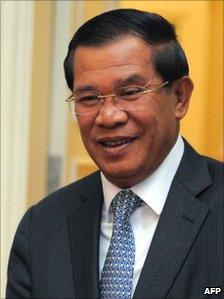Cambodia profile - Leaders
- Published

The king's role is largely ceremonial
Head of state: King Norodom Sihamoni
The son of former king Norodom Sihanouk, King Sihamoni was sworn in as monarch on 29 October 2004. The former king abdicated because of poor health.
Born in 1953, he studied in Czechoslovakia. He left Cambodia for France after the fall of the Khmer Rouge in 1979. He is a trained classical ballet dancer.
Cambodia's kings once enjoyed a semi-divine status; today, the monarch's role is mainly ceremonial.

Cambodia's veteran premier Hun Sen
Prime minister: Hun Sen
Hun Sen, one of the world's longest-serving prime ministers, has been in power in various coalitions since 1985.
He was reappointed by parliament in September 2013 for a further five-year term. The move followed mass demonstrations and came amid a boycott of parliament by the opposition Cambodia National Rescue Party (CNRP), which alleged fraud in the July elections.
The prime minister's Cambodian People's Party won 68 seats in the poll, to the CNRP's 55. The CNRP said it was cheated out of 2.3 million votes, prompting protests by opposition supporters.
Hun Sen is no stranger to controversy. He seized power from his then co-prime minister, Prince Ranariddh, in 1997.
More recently, some Western countries have said his rule has become increasingly authoritarian.
Critics accuse Hun Sen of using a mixture of electoral fraud, corruption and intimidation to maintain what is in effect dictatorial rule.
Born in 1952, Hun Sen joined the Communist Party in the late 1960s and, for a time, was a member of the Khmer Rouge. He has denied accusations that he was once a top official within the movement, saying he was only an ordinary soldier.
During the Pol Pot regime in the late 1970s he joined anti-Khmer Rouge forces based in Vietnam.
Hun Sen has said he will rule Cambodia into his seventies.